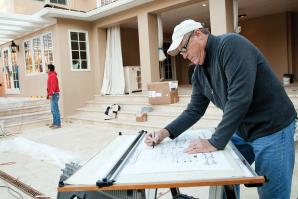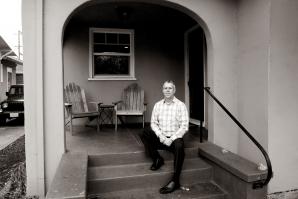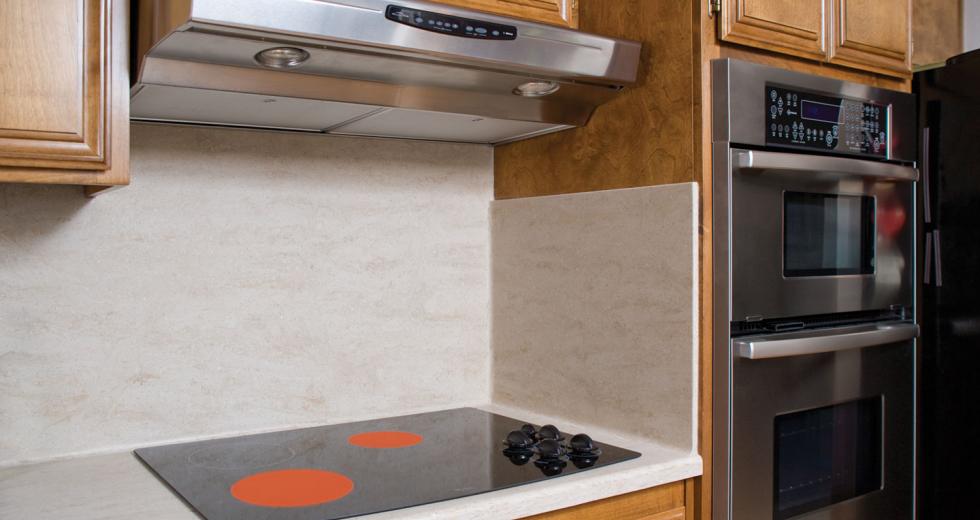Liz Lum knew her 79-year-old mother, Anne Fong, wanted to live independently as long as possible, but Lum also knew that her mother’s Greenhaven house would need some modifications.
“My mother wanted to remodel the house anyway, so the main thing was to accomplish two things at once: Make my mom happy, and make the house safe,” Lum says.
Three steps from the laundry room to the garage now have a permanent railing in place of the milk crates Fong had stacked nearby for support. Fong’s shower now boasts grab bars both inside and out, replacing the panel of glass she had been using to steady herself.
“She looked at the shower and said, ‘Wow, that’s going to make a big difference,’” Lum says.
Fong is one of many senior homeowners in the Capital Region who enjoy independence and aren’t interested in moving to an assisted living facility anytime soon. Instead, they want to age in place and are modifying their homes to make it possible. A recent AARP survey found that 89 percent of people older than 50 would like to stay in their homes indefinitely. They’re interested in maintaining familiar surroundings and remaining close to their personal networks.
Senior home modification for livability is only moderately popular, but there are signs that this trend is gaining momentum. Local remodelers say they are beginning to see older clients express interest in making age-related accommodations to their homes, whether spurred by design trends in senior communities or by the urging of family members. Still, say remodelers, some market factors are stifling the trend.
The most obvious is the economy. No longer do homeowners have piles of home equity to finance remodels and other changes. Not so obvious, however, is the unwillingness of many seniors — and those approaching senior status — to admit they may need home modifications to remain safe.
“I’ve noticed the majority of my clients are at retirement age or approaching retirement age,” says Andy Wright of the Grass Valley-based remodeling firm, WrightBuilt Inc. “They’re spending significant sums of money but are not necessarily thinking forward. There’s a lot of denial out there. It’s a difficult subject.”
Still, those who choose to move forward with such projects can expect to find an increasing number of remodeling companies well-versed in senior home modifications. For many, it is becoming standard to suggest such changes to older homeowners as part of typical remodels. Such forethought not only creates a safe home environment for years to come but also puts those regional homeowners at the front of what will become a national trend.
Take Gary and Kathy Hysell, who simply wanted to remodel their bathroom. While talking through their plans with Wright, the Grass Valley homeowners agreed that it would be smart to include modifications they may — or may not — need later in life.
“When he suggested the ideas, we thought, ‘OK, let’s go ahead and do that since it makes sense to do it now,’” says Kathy Hysell, 55. Gary is 62.
Not only did they get an updated bathroom, but they also have one that will serve them for years to come. Instead of a small shower stall and a Jacuzzi tub, which can become difficult to get in and out of, the Hysells chose a spacious shower with a low lip to step over. Glass panels enclose about two-thirds of the shower; the remaining third is open, adding to the ease of entry. Other touches include grab bars, a built-in bench, traditional and handheld showerheads and control knobs reachable from outside the shower.
The Hysells’ focus on the bathroom is common, Wright says. That’s because it is one of the most often remodeled areas of a home and can also be one of the most challenging rooms for seniors. The Hysells’ changes are representative of the most common modifications for seniors: installation of grab bars (which now come in a variety of decors), barrier-free (or close to it) showers, shower seats and easily accessed handles.
Even if homeowners aren’t ready for such changes now, they can take steps during a remodel to make it easier for such changes later. Wright, for example, always recommends homeowners at least install behind-the-wall blocking for grab bars to be installed later.
The kitchen is also a popular area for age-related modifications. Lowering countertop areas to 30 or 32 inches above the ground rather than the standard 36 can help those with arthritis, says Kent Eberle, president of Sacramento-based DBA Eberle Remodeling. For others, higher countertops might be the right solution. And for many seniors, raising appliances — microwaves and ovens, in particular — to a slightly higher level is important, as is installing cooktops with control knobs along the front rather than the side or back.
To ensure things remain accessible when cabinets and doors are open, Eberle recommends adding more space than required around a newly installed peninsula or island and installing ergonomic hardware on cabinets.
Lighting and color choices can also be considerations. Having plenty of lighting, including beneath cabinets, is helpful for those whose eyesight may be worsening. Visual impairments can also prompt seniors to ask for the sink and countertops to be in different shades so they can more easily distinguish between them.
“If it’s all the same color, it wouldn’t be a good idea,” Eberle says. “You might want to do a dark countertop with a light sink or vice versa.”
Beyond the bathroom and kitchen, standard modifications for seniors include lowering light switches for ease of reach and raising electrical outlets to avoid bending over, says Pete Deterding, president of Carmichael-based Diamond D Construction Inc. Replacing round doorknobs with levered handles can make opening a door easier for those with arthritic hands.
Doorways in general can be a source of frustration — framing a wider-than-average doorway allows wheelchairs and walkers to pass through without difficulty. Eliminating threshold heights in those doorways reduces the trip hazard, and choosing low-pile carpeting also helps. In fact, says Eberle, installing flooring that has some give to it, such as bamboo or laminate, can help in other ways.
“If somebody did fall or have an accident, they wouldn’t be as injured as they would be if they fell on tile or another very hard surface,” Eberle says.
Whether large or small, many senior home modifications carry with them another goal besides safety: making sure the house doesn’t look as though it has been built for seniors. In many cases, Eberle says, it’s difficult for anyone to even notice modifications have been made.
In fact, that is an important tenet of so-called universal design, which is a principle many contractors focus on when handling home modifications for seniors. A relatively new design paradigm, universal design strives to make buildings accessible for all and to make the aesthetics pleasing as well. Accessible design doesn’t have to look institutional; it can look just like home, as shown off in the Eskaton National Demonstration Home in Roseville.
Although the demo house contains features not all seniors will want to include in their homes, it does serve as a model of the variety of modifications available to make aging in place safely more of a reality for senior homeowners. If the AARP survey is any indication, there is a sizeable market out there simply waiting to become part of a full-fledged trend in home modifications for seniors.
“When you stay at home, you’re able to control your environment,” says Mary Yasbec, business partner at Diamond D Construction. “And when you make it safe and comfortable, it doesn’t get any better than that.”
Aging in Place in a New Home
While many seniors will opt to modify their existing homes, some
may choose to move to a new home built with their needs in mind.
Whether in a neighborhood built specifically for older adults or
incorporated into standard new developments, these types of homes
will certainly be needed.
To provide perspective, we spoke with Sheri Peifer, Eskaton’s vice president for research and strategic planning.
Comstock’s: Based on the number of baby boomers, how many new
homes for seniors will the Sacramento region need?
Peifer: In Sacramento County alone, there are more than
220,000 adults over the age of 60, and that same demographic will
nearly triple between 2000 and 2040. According to The Dual
Challenge report by [the Area 4 Agency on Aging], in the year
2000, roughly 90,000 people 65 and older in our region had some
type of disability. Current home construction does not support
those with limited mobility, which can lead to a premature or
unwanted move into an assisted living environment. Livable Design
by Eskaton is a new program that is actively trying to change the
way new homes are constructed to support all ages and abilities,
allowing older adults to remain independent and live in their
homes until they choose otherwise.
Comstock’s: Who is going to build these homes?
Peifer: Eskaton is currently working with Lakemont [Homes] to
build Livable Design homes in their future age-targeted
communities. Eskaton hopes to work with many more builders to
create livable home environments in their new building practices.
Comstock’s: What will be the cost of these new homes?
Peifer: Incorporating Livable Design features into new homes
is considerably less expensive than trying to retrofit supportive
features into a home later. Eskaton asked two major homebuilders
to evaluate the cost to incorporate Livable Design features into
an existing 1,600-square-foot floor plan, and the answers came
back at $3 to $6 per square foot (in builder costs).
Comstock’s: Which areas are ripe for this type of
development?
Peifer: Nationwide, there is a need to change the way homes
are constructed. Even homebuilders focused on the 50-plus
demographic do not construct homes with comprehensive supportive
designs. Livable Design by Eskaton is hoping to change home
construction and to educate builders and consumers on the
benefits of building beautiful, functional, adaptable homes that
will be supportive for a lifetime.
Recommended For You

Back to the Drawing Board
A tale of recessionary redesign
It’s 2 p.m., and John Packowski must design an entire house from scratch by 5 o’clock.

The Accidental Landlord
More homeowners are turning to the rental market for mercy
Brian O’Hearn is an accidental landlord.
Like more and more homeowners caught in the descending mortgage spiral, O’Hearn and his wife, Juliet Williams, faced tough choices. Married in June, they owned his house in Folsom and her Sacramento condo — and both wanted to live in midtown.



